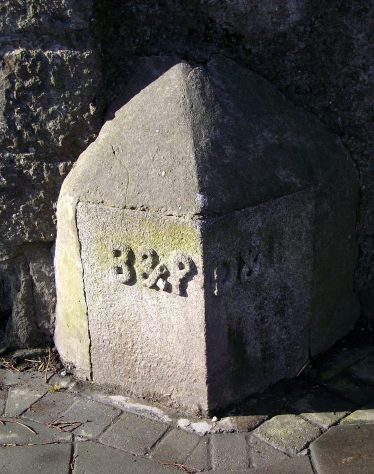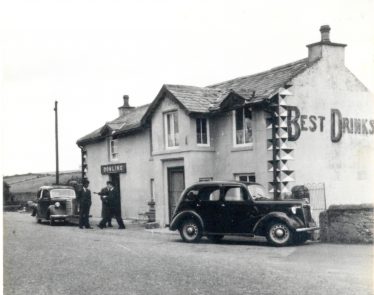We are all well-seasoned commuters on the N81 and intimately acquainted with the continuous traffic. But there is more to it than traffic.
From Terenure you are travelling the route of the Dublin to Poulaphouca Steam Tramway which operated from 1888 to 1932. Eventually it passed the now closed Embankment Pub. The tramway was embanked to provide a gradual rise to this point.
Google maps
Water trough, N81. Jim Butler © 2020
Up the hill towards Crooksling and after Meagan’s Lane, on the left hand side, there is a water trough which was provided for the carters’ horses on their return journey to the granite quarries in West Wicklow. The last house on the left before St. Bridgets Hospital, was originally a constabulary barracks.

Constabulary barracks, N81. Jim Butler © 2020
Brittas, the Lamb and Tinode

Tinode Brick Factory (The Lamb) Jim Butler © 2020
Brittas, which is reached next, used to have a Toll house. The 18th and 19th century toll roads in Ireland were abolished by 1859. Shortly after Brittas is the Lamb. On the left hand side, after the Manorkilbride junction, are the remains of a brick kiln, now sporting some trees growing on its roof. The next house on the left was originally Tinode post office.
A marker stone with the letters B&P/D&B.
Entering Blessington, there is a milestone c1770 on the right hand side. Before Charles Camping on the left, is a good example of a toll house. Opposite Supervalu, there is a marker stone with the letters B&P/D&B.

B&P/P&B stone, Blessington. Jim Butler © 2020
This relates to the Blessington to Poulaphuca and Dublin to Blessington Steam Tramway. Some interesting buildings in Blessington are St. Mary’s Church of Ireland built in 1683, the Monument and water trough built in 1865 by the landlord for his tenants’ benefit and the Market Hall built c1820 which incorporates the Downshire family coat of arms .

The Monument, Blessington with the Market Hall behind. Jim Butler © 2020
Cast iron, wall post box

Side entrance to Russborough House with cast iron post box in wall. Jim Butler © 2020
Leaving Blessington, you reach the Russborough House/Russelstown Park junction. Just beyond this on the right, is a disused gate to Russborough House with an old cast iron, wall post box nearby. Further on, and on the right side, is an interesting gate entrance which was the access to the long gone Russborough post office.
Steam Tram siding and goods shed.

Steam tram goods shed. Jim Butler © 2020
Continuing to the Ballymore Eustace junction, on the right side there is a shed with a red steel curved roof. This is all that remains of the Steam Tram siding and goods shed.
Art deco DCWW water works tower

DCWW Tower, Poulaphuca. Jim Butler © 2020
At Poulaphouca on the right, is the art deco Dublin Corporation water works tower.
Another art deco example is the disused security building of the ESB power station. Across the road from it, the lay-by was the site of the engine house and goods shed for the Steam Tram. The adjacent house was the booking office and passenger waiting room. The Poulaphouca Bridge built in 1829 crosses the river Liffey. In the grounds of the nearby hotel is a World War 11 military bunker.

Poulaphuca bridge. H. Kurchoffer R.H.A. J. Rogers. Image Jim Butler © 2020
Ballysize/Ballymore Eustace junction

Site of constabulary barracks. Jim Butler © 2020
Just before the Ballysize/Ballymore Eustace junction, on the left, the two storey house was a police station. Passing under the high tension power lines before Hollywood Cross, the building on the left set back in a field, was the site of a constabulary barracks.
Piper’s Stones

Piper Stones. Jim Butler © 2020
After Hollywood, on the left, is the entrance to the Piper’s Stones.
Beyond that, is Annalecky Cross and the Tollhouse Pub which itself is dated 1860. However, it also incorporated a toll house up to 1859 when all toll houses were disbanded.

Dowling’s Toll House, Annalecky, 1957. Photo Donard Imaal History Group
Water powered corn mill

Site of Corn Mill near Whitestown Cross. Jim Butler © 2020
At the Whitestown junction, on the right, is a ruined two story building which was the site of an old water powered corn mill.
There is also a good view of the old four-arched bridge over the Carrigower River.

Bridge over Carrickgower river. Jim Butler © 2020
Castleruddery House built in 1810

Entrance to Castleruddery House. Jim Butler © 2020
Continuing on, you pass the entrance to Castleruddery House built in 1810 and you cross the river Slaney via Waterloo bridge.
Beyond that, Stratford-on-Slaney can be seen on the right. In the 1800s, this village had a large linen and cotton industry. Beyond this at Manger, is one of the oldest bridges in the area dated c1750. It has five arches.

Manger bridge over River Slaney. Jim Butler © 2020
Burnt down in 1922

Saunders Grove. Jim Butler© 2020
Next up, on the right, is Saunders Grove built c1925. The original house was built in 1716 but was burnt down in 1922. The remains of a large walled garden in the estate can be seen from the N81.
Tuckmills Cross

Corn mill at Tuckmill cross. Jim Butler © 2020
And lastly on to Tuckmills Cross, where there was another toll gate. The remains of a water powered corn mill are on the left.




Comments about this page
I knew some but not all ! Fascinating evidence made alive with your article and photos, thank you.
Fabulous article, well done. Will pay more attention when next driving up and down!
Hi Ena. Many thanks for your feedback on the N81 article. Regards. Admin
Hugely inspirational piece Thank you When next I am on this road I will pay more attention.
Thank you Vinnie. It was an enjoyable article to work on. Hope your are enjoying our page.
Excellent piece
Add a comment about this page